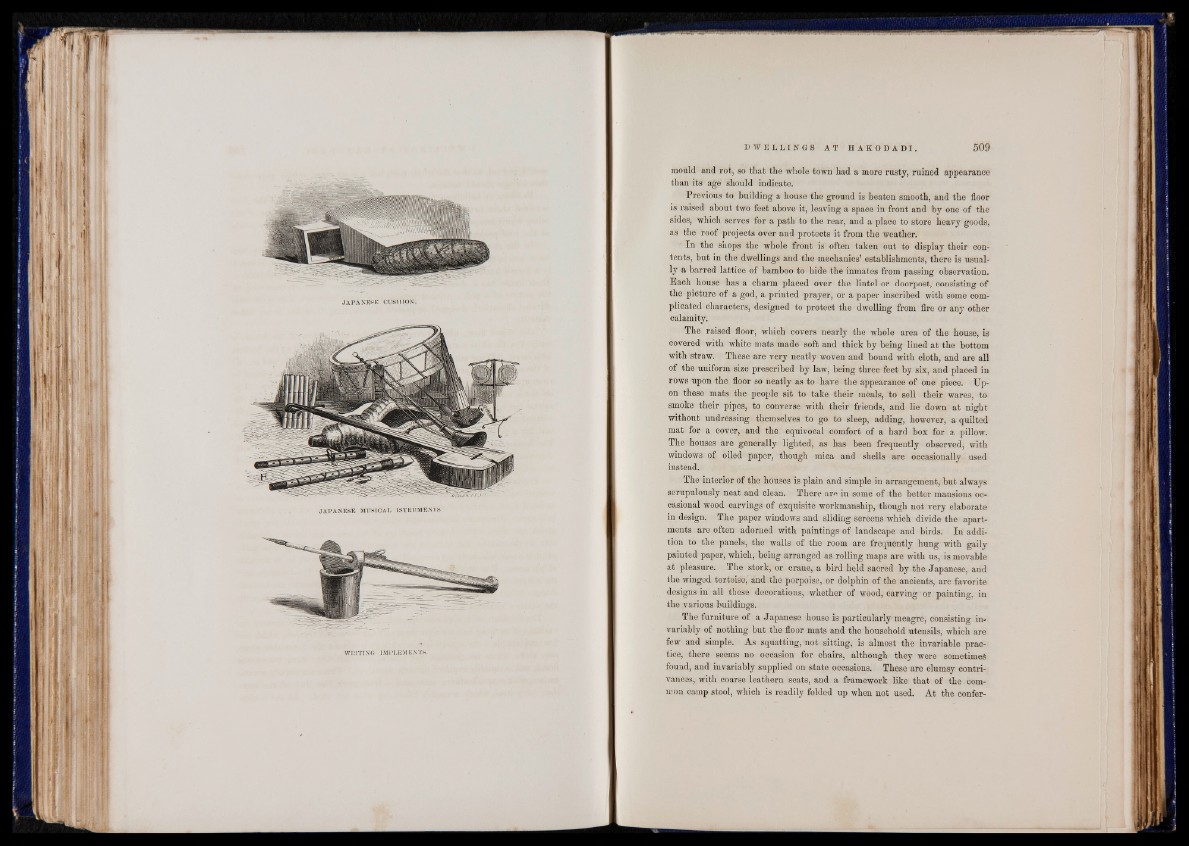
JA P A N E S E CU SH IO N .
JAPANESE MUSICAL ISTHUMEN IS
W IM T IN G IM P L E M E N T S .
mould and rot, so that the whole town had a more rusty, ruined appearance
than its age should indicate.
Previous to, building a house the ground is beaten smooth, and the floor
is raised about two feet above it, leaving a space in front and by one of the
sides, which serves for a path to the rear, and a place to store heavy goods,
as the roof projects over and protects it from the weather.
In the shops the whole front is often taken out to display their contents,
but in the dwellings and the mechanics’ establishments, there is usually
a barred lattice of bamboo to hide the inmates from passing observation.
Bach house has a charm placed over the lintel or doorpost, consisting of
the picture of a god, a printed prayer, or a paper inscribed with some complicated
characters, designed to protect the dwelling from fire or any other
calamity.
The raised floor, which covers nearly the whole area of the house, is
covered with white mats made soft and thick by being lined at the bottom
with straw. These are very neatly woven and bound with cloth, and are all
of the uniform size prescribed by law, being three feet by six, and placed in
rows upon the floor so neatly as to have the appearance of one piece. Upon
these mats the people sit to take their meals, to sell their wares, to
smoke their pipes, to converse with their friends, and lie down at night
without undressing themselves to go to sleep, adding, however, a quilted
mat for a cover, and the equivocal comfort of a hard box for a pillow.
The houses are generally lighted, as has been frequently observed, with
windows of oiled paper, though mica and shells are occasionally used
instead.
The interior of the houses is plain and simple in arrangement, but always
scrupulously neat and clean. There are in some of the better mansions occasional
wood carvings of exquisite workmanship, though not very elaborate
in design. The paper windows and sliding screens which divide the apartments
are often adorned with paintings of landscape and birds. In addition
to the panels, the walls of the room are frequently hung with gaily
painted paper, which, being arranged as rolling maps are with us, is movable
at pleasure. The stork, or crane, a bird held sacred by the Japanese, and
the winged tortoise, and the porpoise, or dolphin of the ancients, are favorite
designs in all these decorations, whether of wood, carving or painting, in
the various buildings.
The furniture of a Japanese house is particularly meagre, consisting invariably
of nothing but the floor mats and the household utensils, which are
few and simple. As squatting, not sitting, is almost the invariable practice,
there seems no occasion for chairs, although they were sometimes
found, and invariably supplied on state occasions. These are clumsy contrivances,
with coarse leathern seats, and a framework like that of the common
camp stool, which is readily folded up when not used. At the confer